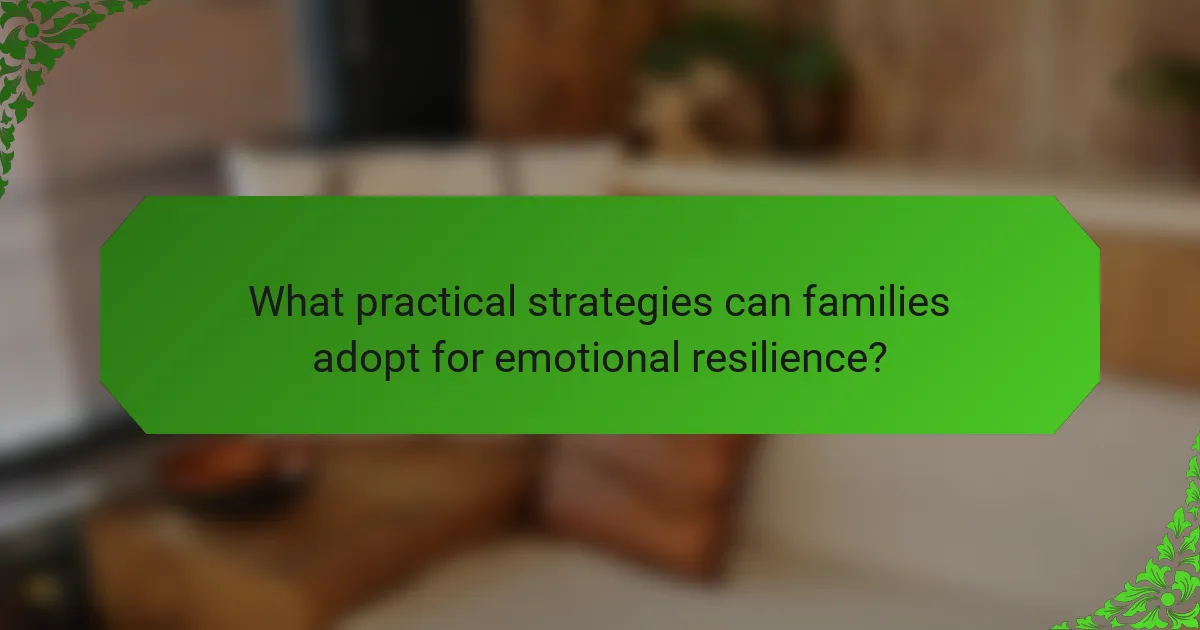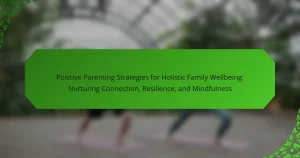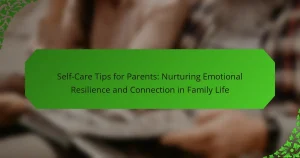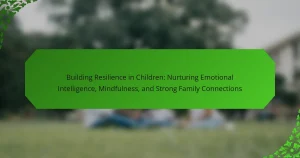Building emotional resilience and connection is essential for family dynamics. Family therapy techniques enhance communication, foster understanding, and promote empathy. Unique approaches like narrative therapy and emotionally focused therapy reshape family interactions. Practical strategies such as open communication and shared activities further strengthen bonds and support emotional health.

What are the foundational family therapy techniques for emotional resilience?
Family therapy techniques enhance emotional resilience through structured communication and connection-building strategies. Techniques such as active listening, validation, and conflict resolution foster understanding and strengthen familial bonds. Role-playing exercises allow family members to explore perspectives, enhancing empathy. Incorporating family rituals creates a sense of belonging and stability, crucial for emotional health. Regular check-ins promote ongoing dialogue, ensuring emotional needs are met. These foundational techniques collectively nurture resilience, enabling families to navigate challenges effectively.
How does communication impact emotional connection in families?
Effective communication fosters emotional connection in families by promoting understanding and empathy. Open dialogue allows family members to express their feelings, leading to stronger bonds. Active listening enhances trust and reduces misunderstandings, which are critical for emotional resilience. Techniques like family meetings and therapeutic conversations cultivate a safe space for sharing, reinforcing emotional ties. In family therapy, these practices are essential for nurturing relationships and enhancing overall family dynamics.
What role does active listening play in family therapy?
Active listening is crucial in family therapy as it fosters understanding and emotional connection. This technique allows family members to feel heard and validated, promoting open communication. By practicing active listening, therapists help families navigate conflicts and strengthen their relationships. This approach enhances emotional resilience, enabling families to address challenges collaboratively. Active listening also encourages empathy, which is essential for building trust and intimacy within family dynamics.
What are the steps to practice active listening effectively?
To practice active listening effectively, follow these key steps.
1. Focus fully on the speaker, eliminating distractions.
2. Show that you are listening through nodding and appropriate facial expressions.
3. Provide feedback by paraphrasing or summarizing what the speaker has said.
4. Defer judgment and avoid forming responses while the speaker is talking.
5. Respond appropriately, expressing empathy and understanding.
These steps enhance emotional resilience and connection in family therapy settings.
How can family rituals strengthen emotional bonds?
Family rituals can significantly strengthen emotional bonds by creating shared experiences and fostering communication. These practices enhance connection through consistency and predictability, which provide a sense of security. Engaging in rituals, such as family dinners or game nights, nurtures emotional resilience by promoting positive interactions and reinforcing family identity. Research shows that families with strong rituals report higher levels of emotional well-being and cohesion.
What techniques foster empathy among family members?
Active listening, open communication, and shared activities foster empathy among family members. These techniques encourage understanding and connection. Active listening involves fully concentrating on the speaker, validating their feelings, and responding thoughtfully. Open communication creates a safe space for family members to express their thoughts and emotions without judgment. Engaging in shared activities, such as family meals or game nights, strengthens bonds and promotes emotional resilience. As a result, families develop deeper empathy and support for one another.

What unique approaches enhance emotional resilience in family therapy?
Family therapy enhances emotional resilience through unique approaches like narrative therapy, experiential techniques, and systemic interventions. Narrative therapy empowers families to reshape their stories, promoting a sense of agency. Experiential techniques, such as role-playing, foster emotional expression and connection. Systemic interventions focus on family dynamics, helping members understand their roles and interactions. These methods cultivate a supportive environment, strengthening emotional resilience and fostering deeper connections within families.
How does narrative therapy help families share their stories?
Narrative therapy helps families share their stories by creating a safe space for open dialogue. It encourages family members to express their experiences and emotions, fostering understanding and connection. This technique allows families to reframe their narratives, highlighting strengths and resilience. As a result, families develop deeper emotional bonds and improved communication skills, essential for nurturing emotional resilience.
What is the significance of art therapy in family dynamics?
Art therapy significantly enhances family dynamics by fostering emotional expression and improving communication. This therapeutic approach allows family members to explore feelings through creative processes, promoting understanding and connection. Studies show that families engaged in art therapy report increased emotional resilience and strengthened relationships. By using art as a medium, families can address conflicts and create a safe space for dialogue, ultimately nurturing a supportive environment.
How can families implement art therapy at home?
Families can implement art therapy at home by creating a dedicated space for creative activities. Encourage open expression through drawing, painting, or crafting. Set aside regular time for these activities to foster emotional connection. Use art to discuss feelings, helping family members articulate emotions in a safe environment.
What role does play therapy have in connecting with children?
Play therapy is crucial for connecting with children by fostering communication and emotional expression. It allows children to process their feelings through play, which is their natural language. This technique enhances emotional resilience by providing a safe space for exploration. Children often reveal their thoughts and experiences indirectly through play, making it easier for therapists to understand their needs. As a result, play therapy strengthens the bond between the child and the therapist, promoting trust and openness.

What rare techniques can be utilized in family therapy?
Emotionally focused therapy and narrative therapy are rare techniques in family therapy that enhance emotional resilience and connection. Emotionally focused therapy focuses on attachment bonds, helping families identify and express emotions. Narrative therapy allows families to reframe their stories, promoting understanding and connection. These techniques foster deeper emotional engagement and strengthen familial relationships.
How does nature therapy benefit family relationships?
Nature therapy enhances family relationships by promoting emotional connection and resilience. Engaging in outdoor activities fosters communication and cooperation among family members. Research shows that time spent in nature reduces stress and enhances mood, creating a supportive environment for open dialogue. Additionally, shared experiences in natural settings strengthen bonds, encouraging teamwork and empathy. Families practicing nature therapy report improved conflict resolution skills, leading to healthier dynamics.
What are the benefits of using music therapy in family settings?
Music therapy enhances emotional resilience and connection in family settings by promoting communication, reducing stress, and fostering bonding. Families experience improved emotional expression, which leads to stronger relationships. Research indicates that music therapy can significantly decrease anxiety levels and enhance overall family dynamics. Additionally, engaging in music together creates shared experiences that strengthen family ties and encourage cooperation.

What practical strategies can families adopt for emotional resilience?
Families can adopt practical strategies like open communication, emotional validation, and shared activities to build emotional resilience. Open communication fosters trust and understanding, allowing family members to express feelings. Emotional validation ensures that everyone feels heard and respected, which strengthens connections. Shared activities, such as family game nights or outdoor adventures, create bonding experiences that enhance emotional support. Implementing these strategies can significantly improve family dynamics and resilience.
What are the best practices for maintaining emotional health in families?
To maintain emotional health in families, prioritize open communication, establish routines, and practice empathy. These practices foster resilience and strengthen connections. Encourage family members to express feelings and actively listen to one another. Regular family activities, such as shared meals or game nights, enhance bonding and create a supportive environment. Implementing conflict resolution techniques can also help manage disagreements constructively, promoting emotional well-being.
What common mistakes should families avoid in therapy?
Families should avoid common mistakes in therapy, such as lack of commitment, poor communication, and unrealistic expectations. These errors can hinder emotional resilience and connection. Commitment to the process is essential for progress. Open communication fosters understanding and trust. Setting realistic goals allows families to measure improvement effectively.
How can families create a supportive environment for emotional growth?
Families can create a supportive environment for emotional growth by fostering open communication and understanding. Encourage regular family meetings to discuss feelings and challenges. Establish a safe space where each member can express themselves without judgment. Utilize family therapy techniques such as active listening and empathy-building exercises to strengthen connections. These practices enhance emotional resilience and promote healthy relationships within the family unit.
What expert insights can guide families in therapy sessions?
Expert insights for families in therapy sessions include fostering open communication, practicing active listening, and setting clear boundaries. These techniques nurture emotional resilience and strengthen connections among family members. Therapists often encourage families to engage in structured activities that promote cooperation and empathy, enhancing understanding and reducing conflicts. Regular reflection on family dynamics can reveal patterns that need addressing, guiding families toward healthier interactions.




